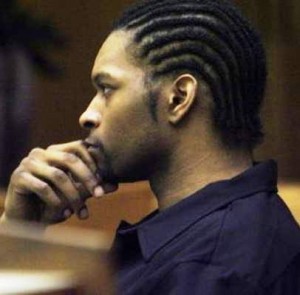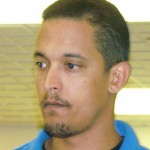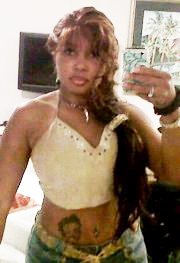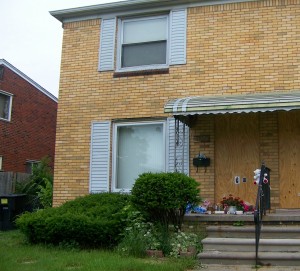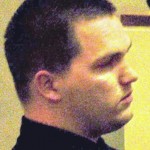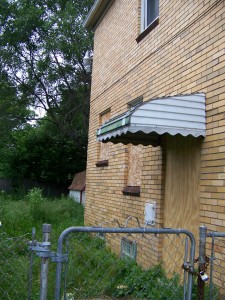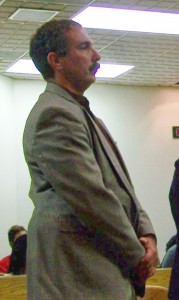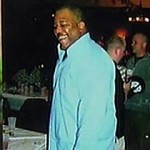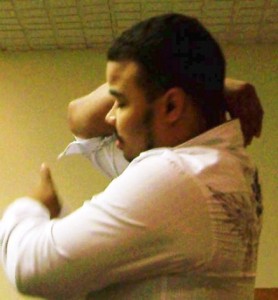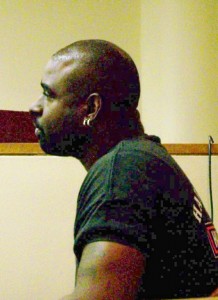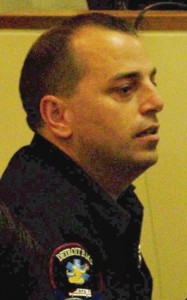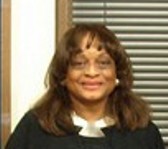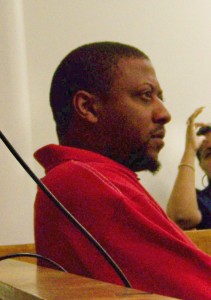-
Next officer on scene says Huff arrived first; neighbor said others there earlier
- Officer who arrested defendant says he saw no weapon
- Scene totally unsecured hours later; house occupant, friend inside with cops
- Defendant stripped naked in street
- Questions re: neighbor’s connections with cops
DETROIT – Conflicting testimony continued during the second and third weeks of the murder trial of Jason Alexander Gibson, 27. He is charged with killing Detroit police officer Brian Huff last May and wounding other officers, along with multiple weapons and marijuana possession counts.
The week of Mar. 7 began with the testimony of officers who were wounded during the shoot-out.
TESTIMONY MARCH 7
On Mar.7, undercover Detroit police officer John Dunlap took the stand and immediately contradicted what was said Mar. 3 by civilian Paul Jameson, who lived next door to 20263 Schoenherr, where the shootings took place.
“I was partnered with Officer Bryan Glover, in a black unmarked four-door truck,” Dunlap said. He identified a photo of Black pick-up truck, which shows it parked in front of Jameson’s house at 20251 Schoenherr during the events. Dunlap said they arrived in response to a “B & E, shots fired” call.
Prosecutor Thomas Trczinski asked him if there were other officers present when he arrived.
Dunlap said the others at the scene were Huff and his partner Joseph D’Angelo, who had arrived in a white marked police SUV parked in the driveway of 20263 Schoenherr.. He said its “overhead” lights were on.
Jameson testified Mar. 3 that other officers were on the scene PRIOR to Huff’s arrival.
“I saw officers gathering in front,” Jameson said. “Officer Huff was coming on the scene then. He kind of like took charge. He was rallying people behind him, in uniform, then pretty much looking through a crack in the door. Two or three officers were close behind. I think he was the only one on the porch. . . . I remember Huff looking back and asking, ‘Are you guys ready?’”
A friend of Jameson’s, who has known him since 1998, told VOD that he is not only a military veteran, as he testified, but an ex-cop, and that he works for the Detroit Department of Transportation as a contractor.
Jameson’s wife Danielle said last year in published remarks that she has a brother and an aunt who are Detroit police officers and that they were stationed at the ninth precinct along with Huff. She also told The Detroit News that her brother guarded the defendant, Gibson, at the hospital after the events. (See sidebar: WHO IS PAUL JAMESON?)
She added that their house had seven surveillance cameras posted around it, but that officers who looked at the camera tapes found “nothing.”
A highly-placed former police administration source has said the duplex was a police-operated drug house.
“D’Angelo was towards the side of the house,” Dunlap said, “and Huff was on the right side of the front door.”
He said he took a position in front of the north side of the duplex, and that Huff “communicated” with him.
“Officer Huff pushes the door the remaining way open,” Dunlap said. “He announces ‘Police’ and steps through the door and begins his entry. I hear three shots from the interior of the house. There is no gap, they are one after the other. I observe Officer Huff fall to the ground. He is lying on the inside of the doorway.”
Dunlap said he saw Gibson run out of the house after Huff was shot. He stood and demonstrated Gibson’s alleged stance, holding his own left arm straight out and pointing his hand at Trzcinski about 15 feet away.
“When the defendant first comes into view, he raises his arm up at me and fires a shot,” Dunlap said. “For a second, he was stationary before he moved south.”
Defense attorney Susan Reed noted for the record that Dunlap had raised his left arm. Trzcinski then asked Dunlap if he knew what arm Gibson was using, and he said “No.” Gibson has been taking notes with his right hand during the trial, and Dunlap said he himself shoots right-handed.
“I begin to back up and to return fire,” Dunlap said. He said he had his gun out but it was not pointed at Gibson at first.
He said he fell to the ground on his back after firing his weapon an unknown number of times. He said Gibson continued to run “south to the left,” parallel to the front of the house. He said he heard other shots, but could not tell where they were coming from/ He then realized he had been shot and was conveyed to the hospital.
On cross exam by Reed, Dunlap said he passed by Huff to take his position, and that only he, Glover, Huff and Huff’s partner Joseph D’Angelo were there when he arrived, “that I was aware of.”
He said he could not recall if either he and Glover or other officers called in on the police radio to say they were backing up the call. He said that although it was a “shots fired” call, Huff did not have his weapon out.
Officer Christopher Champagne, on the force for four and a half years, then took the stand, looking nervous and at first using a low voice. He said he was in a black unmarked Crown Victoria as part of a B&E task force and that Officer Ernie Harris was his partner.
Champagne said Huff was on the ground outside the house with several officers around him when they arrived, in response to an “officer down” call.
“We made our way to the south side of the house where we saw the defendant on the fence handcuffed,” Champagne said. He said Gibson was inside the fence, but he remained on the outside. He said Harris went inside the yard and obtained a semiautomatic handgun that was lying “about a foot away” from Gibson’s head, and gave it to Champagne. He said the weapon and its magazine were empty when he turned it in as evidence.
He identified a silver and black handgun with its serial number obliterated as the weapon they retrieved. Champagne said he then entered the house on all three levels to clear it, and then used yellow crime scene tape to secure the scene.
On cross-exam, Champagne said he did not hear a “shots fired” call prior to the “officer down” call. He said he and Harris parked their car behind the black pick-up truck driven by Dunlap and Glover. He told Reed a third officer, Sgt. Rayshaun (sp?) Gaines, also entered the backyard to retrieve the gun.
“You were not there when the gun was put there or dropped there or anything, right?” Reed asked. Champagne said “No.” He also said he did not know how the gun got there. He said his partner “threw” the gun to him, but changed that testimony to “handed it” on re-direct by Trzcinski.
During his testimony, and that of other witnesses, the officer in charge, who has assisted Trzcinski throughout the trial, exited the courtroom and entered the witness room several times, spending a few minutes there each time.
Huff’s partner D’Angelo, a 17-year-old veteran of the force, followed Champagne to the stand. He had shaved off his thick moustache and cut his hair, which appeared to have grayed more since the preliminary exam last June.
D’Angelo arrested Gibson, handcuffing him to the fence on the south side of the duplex. He confirmed his testimony from the preliminary that he saw no gun near the defendant, even though he illuminated him with his flashlight.
D’Angelo said that individual night was only the fourth time that he and Huff had partnered with each other, because their regular partners were “not available.” He said Jameson told him that someone was going out the back of the house.
However, Jameson testified Mar. 3 that he had checked the backyard of the house and found it to be secure, with no one there, and no window screen out, before he went to the front yard of his own house.
In a hoarse voice, D’Angelo said he ran to the backyard, and jumped the chain link fence. He said the windows on the side of the house were boarded up, and the side door was barred. He said he noticed that the upstairs window screen in back was on the ground, but saw no one in the yard. He said he was using his department-issued flashlight. D’Angelo said he called to Huff that it was a “good B&E” as opposed to a false alarm, and that he could see Huff in front of the house as he talked to him.
“Then I heard him yell ‘police,’” D’Angelo said, and began crying. “He’s at the front door, I’m at the corner, I hear several gunshots.”
He said his first reaction was to take cover, and he turned to go back to the rear of the house, then stopped and turned to go around to the front.
“At the same time, I saw an individual going out of the house, and saw the individual jump the fence,” D’Angelo said. “At first I thought it was my partner.”
D’Angelo, who said his height is 6 feet, 3 inches, and weight 220 lbs, said Huff was shorter than he but “two to three times my girth, a very large man.” Gibson is tall, broad-shouldered but slenderly built.
D’Angelo said he noticed he was shot when he saw “the individual” coming from around the front of the house. He said he couldn’t tell if the individual had a gun.
“The individual fell over the fence literally in front of me,” he said, and identified Gibson in the courtroom. “I illuminated him with my flashlight and realized it was just a suspect and someone getting away. He was sitting on his derriere with his back against the fence, his right hand at his side and his left hand in front of his chest. I had the individual raise his left hand, then his right hand.”
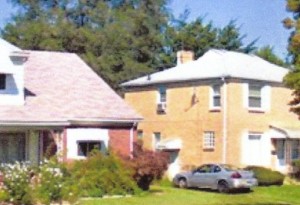
Undated Google map photo of side of 20263 Schoenherr shows south side of house not boarded up; it is unclear why the lower windows and door were boarded up by May, 2010, despite alleged occupancy by Lawrence Bolling (see photo at right above which shows house at time of Huff's murder)
D’Angelo said he used two pairs of handcuffs to secure Gibson’s hands to the fence in a “Y” formation, then went to the front of the house to help with his partner and clear the house before he was driven to the hospital.
D’Angelo identified a photo of a gunshot wound in the inside of his right leg, just short of his groin. He said he had his gun out but never fired it.
On cross-exam, D’Angelo said “other officers” were with Huff at the time he talked to him, but that he didn’t remember who, how many, and whether they were African-American or Caucasian, although they were male. He said he didn’t see any “flashes of light” as the “individual” came towards him, and did not see the individual shoot at him.
He said he saw no weapon when he handcuffed Gibson to the fence, and that if he had seen it, he would have moved it away from Gibson.
Officer Kaspar Harrison, a four-year DPD veteran who was partnered with Officer Stephen Schram, said they were the primary unit dispatched, on a “shots fired in an unoccupied dwelling” call. He contradicted Dulap’s testimony, saying he said he did see Huff on the porch,
“Officer Huff turned around and said someone was still in the location,” Harrison said. “I took my weapon out of my holster, under the impression he was getting ready to clear the house. Officer Huff turned around and asked ‘Are you ready,’ and made entrance into the house as he announced ‘police. As soon as he made entry, I heard two or three shots inside, boom, boom, boom.”
Harrison said he took a position at the intersection of the walkway to the duplex and the sidewalk. He said a barrage of gunfire then began, while he tried to figure out what was going on.
“There were flares coming from the doorway of the unoccupied dwelling, the right hand side door that’s barred up in the photo” He identified the doorway of 20265, north of the side of the duplex that Huff had entered. He said that he could see “pretty much throughout the house” but did not see Huff’s body.
“Then I see someone running out of the location,” he testified, but said he only saw a “shadow.” He said he could not see if the person was a man or a woman, and did not identify Gibson in the courtroom. He said his view was blocked by officers Dunlap and Glover, among others.
Harrison said he ran north up the sidewalk looking for cover and was shot in the arm. He said he fell forward and hurt his face and teeth when he hit concrete, in the process accidentally discharging his gun. He said he was in the hospital for three days with a broken arm and did not return to work until after Christmas.
On cross-exam, he told Reed that Huff, D’Angelo and Dunlap were the only three officers he saw when he arrived on the scene. Reed had him read his testimony at the preliminary exam, during which he said that the figure coming from the doorway was running west towards him, and then he didn’t see him anymore.
That testimony conflicted with Dunlap’s, who said Gibson ran south towards the side of the house.
TESTIMONY MAR. 8
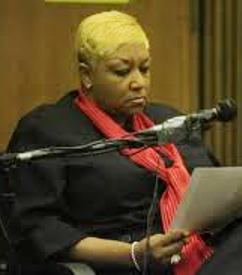
Officer Huff's wife Melissa Huff said his last text to her at 3:15 a.m. was that he had to turn off his phone to take a breaking and entering run; 911 call was not taken until 3:34 a.m.
On Mar. 8, long-awaited bombshell testimony, the actual 911 tape of the call made by Danielle Jameson, wife of Paul Jameson, was presented. It was earlier unsuccessfully sought by reporters through Freedom of Information Act requests, Many had questioned why Officer Huff, a 12 year veteran, would have entered the home with his gun in its holster if he had received a “shots fired” call.
His wife Melissa Huff told reporters during a break in the proceedings that she and her husband had been texting each other all night, and that Huff told her at about 3:15 a.m. that he had to turn his phone off because he had a “breaking and entering” run.
Danielle Jameson took the stand to verify the tape of the call.
“I was asleep in my bedroom on the second floor, and I heard a loud crash and bang,” Danielle Jameson testified. “I wasn’t sure what it was. My husband told me to call the police. I grabbed my cell phone and called 911.”
Trzcinski then played a recording of the call, in which the operator is heard identifying the date and time as May 3, 2010 at 3:34 a.m. There is a long pause after the operator says “911, what is your emergency,” repeating herself several times. Then Jameson is heard identifying her address.
“I’m next door to the neighbor and I hear shots in the house, I never lived in there,” Jameson says.” She says the house is vacant and describes the building and describes the shots as a “pop, pop, pop,” and says she thinks the sounds are from inside the house. The operator says she will notify police.
Her husband testified earlier that he heard “kicks” or “thumps” at the house, but did not mention gunfire.
Jameson said she was walking downstairs to check on her children as she was making the call.
“I asked my son where did Dad go, and he said he went outside,” Jameson said. “After I checked on my daughter, I looked out the window on the first floor closest to the house. I saw my husband just walking around towards the front porch. Then I heard a lot of shots.”
Jameson said after telling her son to watch the couple’s daughter, who is physically and mentally disabled, she went back upstairs to look out the window closest to the house.
“I saw my husband outside on the grass doing what looked like CPR on someone,” Jameson said. She then went back downstairs to reassure her daughter and said she saw flashing lights from police cars, but couldn’t say how many were there.
On cross, Jameson told Reed she wasn’t sure if she had heard shots fired before making the 911 call, but that she did tell police in her statement that shots were fired. She said she was not sure if she saw her husband with police officers before the shootings occurred. She was asked if he took his gun when he left the house.
“I know my husband, he’s going to make sure he’s safe,” she said.
She said she saw no one shooting when she looked outside the upstairs window the second time.
According to her Facebook page, Jameson works at a casino. She posted a comment to her husband on the page: “You’ve been MY HERO since the 80’s. So sorry for Ofc. Huff’s wife & son. I still feel semi responsible for his death but you Paul, are the bravest-take charge-inest man I know and a great role model for our Paul III. I love you always ♥ “
During the rest of the day and on Mar. 11, Trzcinski took testimony from various forensic personnel, a federal agent, and finally from the EMS technician who tried to revive Huff. His was emotional testimony which Trzcinski saved for the end before the jury’s break for the week-end.
The federal agent, Michael Deventier of the Bureau of Alcohol, Tobacco, Firearms and Explosives IATFE), identified 36 items of evidence, which included firearms, bullets and shell casings given to him by the Detroit Police. He said he took the evidence to the ATFE lab in Ammendale, Maryland and later returned it to Detroit police. Two separate lists were entered into evidence, one which was a receipt FROM the Detroit police for the return of the items, and one which was the ATFE’s own list of the items.
On cross, Reed pointed out discrepancies between the lists, which Deventier said resulted from different methods used by local police and the feds to identify evidence. She asked Deventier if he could identify which bullets and shell casings came from which guns, and he said he couldn’t. It was unclear from his testimony exactly what analysis was done by the ATFE.
Gruesome testimony from Detroit Fire Department paramedic Michael Liagre rounded out the day.
Liagre said he knew Huff, referring to him as Brian, and other officers on the scene. He testified that when he arrived, a man he assumed to be a police officer but later discovered was neighbor Paul Jameson, was performing chest compressions on Huff. Liagre said Huff’s sidearm was still in its holster.
When he and his partner got Huff into the EMS vehicle, he said they immediately began resuscitation efforts, but could not intubate Huff, one of only two times in his 13-year career he was unable to do so. Huff had been shot twice, once in the cheek and once in the jaw, according to his autopsy report.
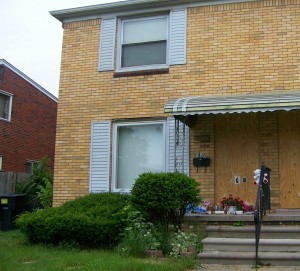
Photo shows concrete porch and steps which Jameson and another officer dragged Officer Huff down by the legs while he was lying on his stomach
“There was so much blood, so much lung tissue,” Liagre said. “Because of the damage created by the path of the bullet, there was no structure left in his face. There was nothing left to pull or push on to explore his airway.”
Jameson testified earlier that he and another officer pulled Huff, who weighed around 400 pounds, by his legs out of the house to the lawn before Jameson began CPR attempts. Jameson said Huff was “on his belly,” meaning his face likely hit the concrete porch and steps before they laid him on the lawn. They then attempted to shove him into his police car to take him to the hospital instead of waiting for the paramedics, who arrived within minutes.
Danielle Jameson’s call of “shots fired,” was at 3:34 a.m., some minutes before Huff even arrived on the scene. Liagre said his unit made the scene at 3:47 a.m., and that by 3:55 a.m., Huff was “asystole,” or flat-lined, likely dead, but that they continued resuscitation attempts.
Trzcinski ended that day’s testimony by reading a stipulated statement into the record, signed by himself, Reed and Gibson, indicating that Gibson was a convicted felon and “had no right to possess or use a firearm”
Judge Hathaway asked whether it addressed a specified felony, which it did not.
It was unclear if the statement was a substitute for Trzcinski’s proposed introduction of testimony from police officers involved in two of Gibson’s earlier arrests, one of which has not yet been adjudicated. In both cases, he was stopped on the street and searched by officers who claimed he resembled suspects in crimes committed hours earlier. The stops were of questionable legality. Judge Gray-Hathaway, however, allowed the testimony to be introduced.
Reed argued at a hearing in November that the incidents showed Gibson did not confront police, but ran from them instead.
Testimony resumed Monday Mar. 14 which drastically contradicted earlier versions of events and contrasted EMS personnel’s treatment of Huff and Gibson, who was wounded in the left buttock during the events. Testimony has not yet shown who shot him.
EMS technician Steven Hazelett said he treated Gibson at the scene, after first finding him standing on the curb outside the house with police officers. He said he stripped Gibson naked OUTSIDE the EMS vehicle, which was parked in the middle of Schoenherr.
“I cut off all his clothing, and a green leafy substance had fallen out somewhere, from his upper half when I cut off his shirt,” Hazelett said. He said his unit received the call at 3:52 a.m. and arrived on the scene at 3:58 a.m. That was three minutes after Huff had gone “asystole” in Liagre’s ambulance, according to that technician’s testimony.
Hazelett said he left the clothing in the street before putting Gibson in the ambulance, and identified a photo earlier placed into evidence which showed clothing in the street, along with a gallon-size bag of purported marijuana. It is unclear how officers Dunlap, who arrested Gibson, and handcuffed him to the fence, and Champagne, Harris and Gaines, who took him to the street curb, missed such a large item in his shirt.
Testimony given earlier by Tonya Wright, who lived across from where the clothes were left, also contradicted Hazelett’s testimony.
“The way it is in the picture — it wasn’t like that,” Wright said, as quoted in the Detroit News. “I didn’t see any marijuana until the officer took the clothes off the back of the car and threw them on the ground.” Go to http://detnews.com/article/20110309/METRO/103090425/Details-of-Huff-s-death-prompt-wife-to-leave-courtroom#ixzz1GlrTM21m to read entire News article.
Additionally, testimony given by forensics technicians earlier in the trial indicated that Gibson’s clothes were gathered at St. John’s Hospital by medical personnel and placed in a hospital bag before being turned over to police. Earlier testimony also indicated there was no gunshot residue on Gibson’s clothes. (Go to http://detnews.com/article/20110310/METRO/103100477/Jury-sees-bullet-fragments-removed-from-slain-Detroit-police-officer#ixzz1GfN3ekzm for reference to the gunshot residue.)
On cross exam, Hazelett said he cut Gibson’s shirt off first, although the blood he observed on his clothing was below the waist and in back of his body. Hazelett testified he found an entrance gunshot wound in Gibson’s left buttock but saw no evidence of an exit wound.
But the most astounding evidence of the day was from Lawrence Bolling and his cousin Laderick Barlow. Bolling said he had lived at 20263 Schoenherr since January, 2010, renting from his other cousin Dwayne Little. Danielle Jameson said in her 911 call that the unit was unoccupied, and photos entered into evidence earlier showed no beds, clothes in the closets, or dressers. Barlow said he had visited him there often.
The two testified that they were allowed into the house around 4 to 5 p.m. on May 3, about 12 hours after the killing of Officer Huff. Barlow said other officers were present both inside and outside the house, and that the yellow crime scene tape had been removed by then.
A Lawrence Ray Bolling took a plea bargain in 2004 for “attempted carrying of a concealed weapon;” he was originally charged with CCW, which would have meant a mandatory two-year jail term. Instead, he got two months in the Wayne County Jail, according to court records.
He said that not only did he enter the house, but he removed a “half-inch” bag of his marijuana that he had for “personal use” from a kitchen cabinet, along with some clothing he had left in the dwelling. He and Barlow denied that a gallon-size bag of marijuana police said they found next to a bin in the dining room was his, and said it was not there when he left the house at 2 p.m. May 3.
Testimony has not been presented yet which would show why someone would break into the house, which Bolling said was secure when he left, and leave a bag or bags of marijuana
He also said that he and his uncle Alonzo Little boarded up the front door of the house before leaving the scene. Crime scene technicians said earlier in the trial that they returned to the unsecured scene a week later to obtain more evidence, including a gray plastic bin, had never been dusted for fingerprints. According to testimony in the preliminary exam, the bin contained marijuana.
(Go to http://detnews.com/article/20110310/METRO/103100477/Jury-sees-bullet-fragments-removed-from-slain-Detroit-police-officer#ixzz1GfN3ekzm for reference to the gray bin’s recovery. This author was not able to be present during every day of the trial.)

